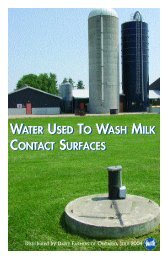Canadian Quality Milk On-Farm Food Safety Program - Centre ...
Canadian Quality Milk On-Farm Food Safety Program - Centre ...
Canadian Quality Milk On-Farm Food Safety Program - Centre ...
You also want an ePaper? Increase the reach of your titles
YUMPU automatically turns print PDFs into web optimized ePapers that Google loves.
<strong>Canadian</strong> <strong>Quality</strong> <strong>Milk</strong><br />
5.3.2 Getting Accurate Results for Antibiotic Test Kits<br />
The following are the Best Management Practices you can apply to ensure your test kits<br />
give an accurate result:<br />
Use a kit designed to detect the antibiotic that was used to treat the animal to be<br />
tested.<br />
Ensure the kit expiry date has not been exceeded.<br />
Ensure the kit is stored properly, and follow the test procedure exactly ⎯ including<br />
testing a known negative milk sample.<br />
Test milk collected only after the recommended withdrawal time has been observed.<br />
Test only milk that is visually normal.<br />
Retest milk that gives a positive test result, using a different test where possible.<br />
Consult with your veterinarian, milk inspector or personnel at the laboratory that<br />
performs official testing when interpreting test results.<br />
5.4 SUMMARY OF HAZARDS AND BEST<br />
MANAGEMENT PRACTICES<br />
HAZARD SOURCE BEST MANAGEMENT PRACTICES<br />
Communicable disease<br />
(from people)<br />
• Dirty hands and<br />
clothing<br />
Environmental bacteria • Dirty teat and<br />
udders<br />
• Dirty hands<br />
• Contaminated<br />
milking equipment<br />
• Infected animal(s)<br />
Colostrum • Recently freshened<br />
cows/heifers<br />
BIOLOGICAL<br />
Practice personal hygiene.<br />
Wear disposable gloves.<br />
Establish a SOP for pre-milking.<br />
Establish a SOP for milking.<br />
Ensure teats are cleaned, sanitized and dried.<br />
Establish an SOP for milking animals with<br />
abnormal milk.<br />
Discard abnormal milk.<br />
Use single-service towels to prep teats.<br />
Ensure the environment is clean.<br />
Practice personal hygiene.<br />
Sanitize milking units.<br />
Segregate cattle.<br />
<strong>Milk</strong> infected cattle separately.<br />
Forestrip and milk-out properly.<br />
Examine udder.<br />
Teat-dip after milking.<br />
Do not add milk to bulk tank from animals 15<br />
days prior to calving or 3 days after calving.<br />
5—12<br />
June 2010
















